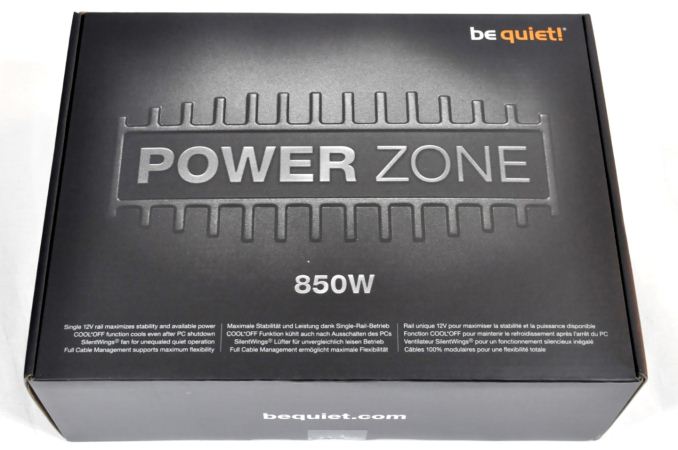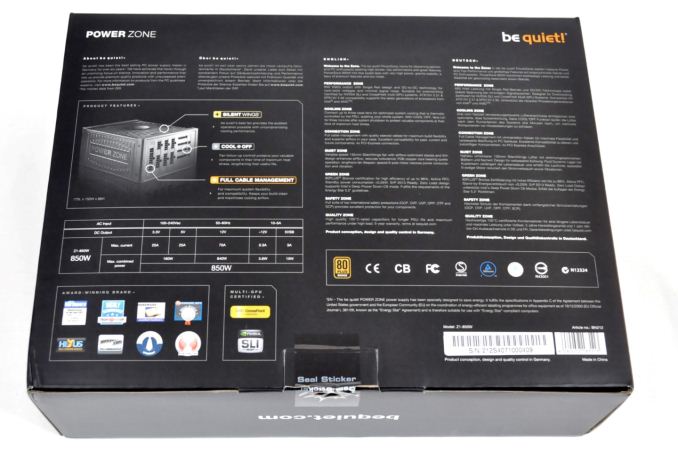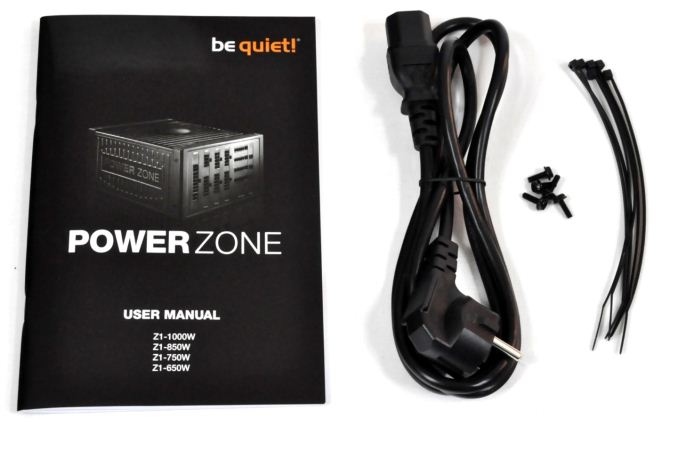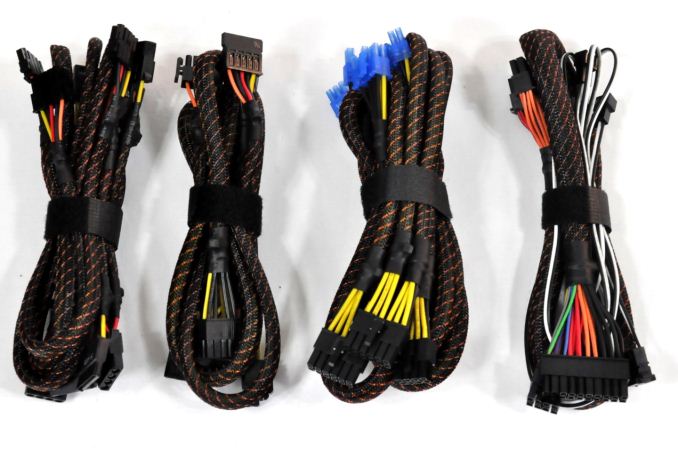be quiet! Power Zone 850W CM Power Supply Review
by E. Fylladitakis on August 14, 2014 6:00 AM EST- Posted in
- Cases/Cooling/PSUs
- PSUs
- be quiet!
- FSP
- Fortron/Source

Introduction
be quiet! is a German company that is slowly making their way into the North American market. As you might guess from the name, be quiet! specializes in low-noise computer PSUs and coolers. (And yes, if you're wondering, the exclamation point is part of the company name, and it's supposed to be all lowercase as well.) Although they currently have a large number of interesting products, we've only had a chance to review a few of their products. It's been some time since we last looked at any of their PSUs, but be quiet! has sent us their Power Zone 850W CM, one of their most popular products right now.
The Power Zone is be quiet!'s "Gaming" series, meaning that they are not meant to be top performers but balanced between high performance, aesthetics, and value. As the name of our sample suggests, it has a maximum output of 850 Watts at 50 °C and is a modular (CM = cable management) unit. It is also 80 Plus Bronze certified and covered by a 5-year manufacturer's warranty, which is good for a middle-range product. be quiet! has a very long and impressive list of features for this unit, which we will examine in this review. However, the most surprising part about the Power Zone 850W CM PSU is not its list of features but the retail price. At $159.99 plus shipping, it is one of the most expensive 850W units available, regardless of specifications. Does it really worth such a steep price tag? Read on to find out.
| Power specifications ( Rated @ 50 °C) | |||||
| AC INPUT | 100 - 240 VAC, 50 - 60 Hz | ||||
| RAIL | +3.3V | +5V | +12V | +5Vsb | -12V |
| MAX OUTPUT | 25A | 25A | 70A | 3.0A | 0.3A |
| 160W | 840W | 15W | 3.6W | ||
| TOTAL | 850W | ||||
Packaging and bundle
be quiet! supplies the Power Zone inside a sturdy cardboard box with a dark theme based on the series logo. The rear of the box has a short overview of the product, with adequate information about the unit and its features. We found the unit very carefully packed inside the box, protected by cardboard pieces, polyethylene foam slabs, and a cloth bag.
The bundle is minimalistic with only a manual, an AC power cable, a few cable straps, and black screws included. Note that these screws are longer than your typical M3 case screw and are necessary for the installation of the Power Zone 850W CM inside a case, as typical screws are not long enough.
The cables of the Power Zone 850W CM are all sleeved and with color-coded wires, yet the sleeving is not so typical. Instead of using plain black sleeving, be quiet! uses a dense sleeving with orange-red thread traces. The sole exception is the fan power cables, which use two plain black/white wires. Four cable straps hold the cable packs together and can be repurposed after the PSU has been installed inside a case.














20 Comments
View All Comments
blackmagnum - Thursday, August 14, 2014 - link
Bean-counters ruining geeks' work once more.StrangerGuy - Thursday, August 14, 2014 - link
Compared to a Seasonic OEMs this is pretty rubbish in comparison, let alone the better Superflower OEM designs.Samus - Thursday, August 14, 2014 - link
Seriously...50db?My 8 year old PC Power Cooling 750 Quad uses an ancient design with an 80mm fan and I don't think the fan has ever exceeded 1500RPM (~36db) so anything modern should exceed this, especially for $160. As said, Seasonic, Superflower, and one of my favorite budget PSU OEM's, FSP, are all considerably better options at this price.
Fortron (Sparkle) are pretty good PSU's but I wouldn't spend more than $40 on one as a low-watt office PC replacement.
Tunnah - Thursday, August 14, 2014 - link
My thoughts too. I have a 3-4 year old Silverstone that cost £80 (I guess about $130 back then), 650w and used for SLI, and you barely hear a peep out of itDanNeely - Thursday, August 14, 2014 - link
Have you ever actually had your PSU at >90% load? Comparing your PSU at a load significantly below max to a second one at full load isn't a fair comparison.What does surprise me is that the fan speed curve on this one appears to be linear. The last time I was shopping for PSUs (a few years ago); most of the ones I saw that showed a fan curve kept the fan at it's minimum speed (or completely off?) for the bottom part of the load curve and only started ramping the speed when it got within 250-300W of max power, mostly relying on passive cooling below that point. I've used that observation for sizing PSUs to a target size of MaxLoad+250W so the fan never spins up adding to system noise.
Streetwind - Thursday, August 14, 2014 - link
As a gamer who assembles their own systems, I make a conscious effort to never buy any component that's explicitly marketed "for gamers" - with the sole exception being the graphics card, of course.This review just underlines once again why that practice is a good practice. Here we have a gamer-targeted product that's too highly powered for the average modern gamer PC, offers only mediocre efficiency and performance, errs on the side of unnecessarily hefty cooling and mounts an unreasonable price tag... and the biggest selling point is a different looking outer shell.
My own PSU is from be quiet!, too. But it's not from this gamer-targeted Power Zone series. No, I chose a Straight Power E9 series part with a wattage rating suitable for a single-GPU system. It is practically inaudible even under load, is rated 80PLUS Gold, was tested for excellent voltage regulation and, get this... cost only half the price of the unit tested in this review.
Seriously, people. Stay away from "for gamer" products. Especially if you're a gamer.
romrunning - Thursday, August 14, 2014 - link
There are far too many reviews for these high-powered PSUs when most people are only running a single GPU. Too many neophyte gamers think they need 750W+ when most can easily get by on 400-550W.We really need more reviews showing the practical power needs of a typical gaming system, and then focus on the PSUs to power them. Just because lower-output PSUs are lower in price doesn't mean we should spend an inordinate amount of time reviewing the higher-powered ones with the higher price tags. Sadly, the "quality" that may or may not be in a mfg's higher-powered PSU doesn't always trickle down to their lower-output models, so it would be good to highlight the ones that are or aren't quality choices at the lower to mid-range.
lmcd - Thursday, August 14, 2014 - link
Do I qualify if I also have a i7-3960X? Probably. But if I'm re-encoding and streaming video in the background while I play a visually-intensive game, I'd rather not have my power supply be the bottleneck. 140 W from my video card and 200 W from my CPU don't really add up to 750W.But maybe I want another card? Especially with AMD CPU buyers, that scenario is common: a desire for upgradeability encourages the $30 for a higher-wattage power supply, as opposed to paying $50 for the 500W then another $80 for the 750W.
Sidenote: given how low the power consumption of Intel CPUs has gotten I'm surprised more manufacturers haven't considered supporting 4x 6pin or even 2x 6pin + 2x 8pin configurations on 550W and 60W PSUs. Connector count, in many cases, can drive the new system builder to the higher-wattage power supplies.
DanNeely - Thursday, August 14, 2014 - link
I think they tend to err on the side of caution since they'd take the blame if someone did overload one; and they can't assume people will only use them with cards that barely need a 6+6 or barely need a 6+8 configuration.4x 6 pin at 600W might be OK, since that'd be 2x 225W GPUs + 100W CPU/mobo + 50W drives/fans/etc = 600W total; but 4x6 GPU power connectors on a 550W PSU could go over the limit easily enough. 2x6 and 2x8 would on 600W would be even worse since that's promising enough power to run a pair of 300W GPUs.
inighthawki - Thursday, August 14, 2014 - link
A good 750W PSU is good enough for even a dual SLI 780Ti system. At 550W, even a demanding single GPU system should have more than an adequate supply of power.However in practice, some people buy these larger PSUs for two reasons:
1) Possibility of future expansion. When I bought my PC last summer, I purchased a larger wattage PSU because I was still debating whether or not to get a second PSU. I haven't yet, but if I decide to, I already have enough power.
2) PSUs generally get their best efficiency while running at 50-60% load. So having a 750W PSU to power a 400W system provides the best efficiency. (Granted I realize for many this is a silly point, since the extra cost of the PSU itself generally will outweigh any cost savings, but maybe they like to be green, or just have the money)